|
Week ending: 24th April: Doonfoot
Finally, after a five-week gap, John and I set off together for a day of watching, and
photographing, nature. Our destination was Doonfoot, on the south of Ayr. My WeatherPro app
predicted near ideal conditions, dry and sunny, although with a chilly East wind. On the down
side, the BBC tidal prediction was a very low tide for most of the time of our visit.
So after a decent breakfast in Stewartfield Morrisons, East Kilbride (9/10: slow service, but very
good food), we drove down the M77 to the Greenan Castle car park in Doonfoot. We set off on a
circuit which took us South along the beach, past the castle. The beach and seashore looked
entirely devoid of birds so we decided to concentrate more on the dunes and hinterland.
The first part of that route was along a hedge-lined strip of short grass at the edge of the low sand
dunes. John spotted a Red Admiral butterfly that was sunning itself on some Nettles. The
descending tones of a Willow Warbler caught our attention and I managed a distant shot as
it sat atop a Hawthorn bush. There were Red Deadnettles and Dove’s Foot Cranesbill on the grass
strip.
| Red Admiral Butterfly |
Willow Warbler |
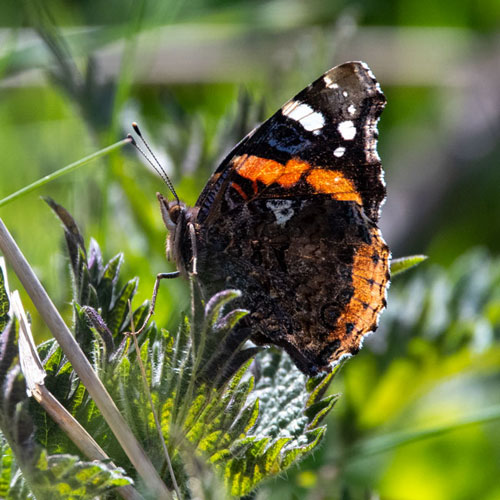 |
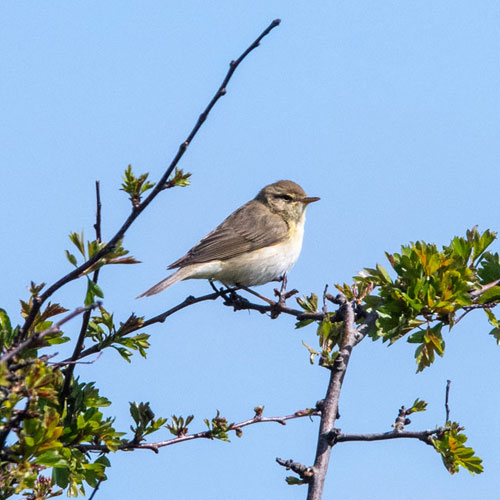 |
| Red Deadnettle |
Doves-foot Cranesbill |
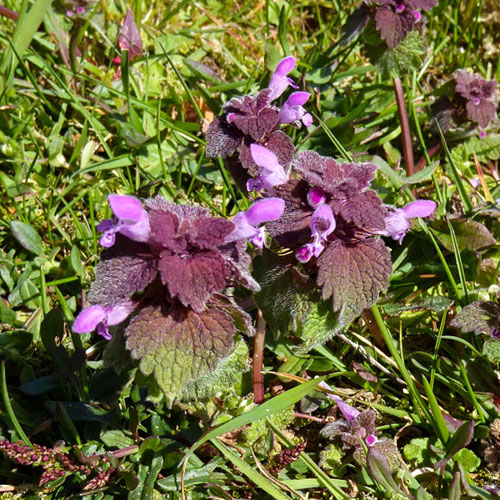 |
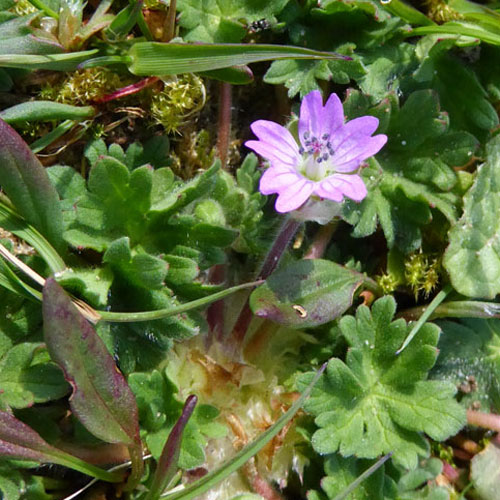 |
We next encountered more Willow Warblers in the bushes just north of the Castle. Without much
effort from us these allowed us some very close pictures. That was probably because they were
obviously in reproductive mode and we were very still and careful not to upset them. We also
encountered several brief sightings of Goldfinches, however they were very elusive and I didn’t
manage one shot of them. Near the base of the Castle’s rock I was pleased to find and
photograph a few shots of Greater Stitchwort and Lesser Celandine.
We walked along the edge of the field to the South of the Castle, where we were delighted to find
a Greenfinch feeding on the bushes. We also saw a singing Whitethroat belting out
what seems to the human ear to be random series of notes. More Goldfinches taunted us as they
played hide-and-seek, again without getting a photo. However, we were also visited by a Small
Tortoiseshell butterfly and then another Red Admiral. I was able to capture images of them as they
briefly paused for a recharge of heat from the sun.
| Greenfinch |
Whitethroat |
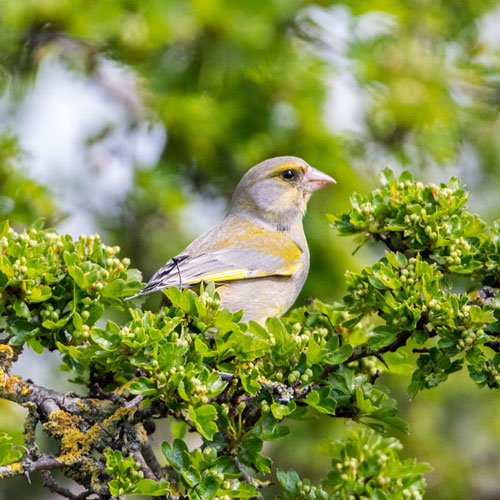 |
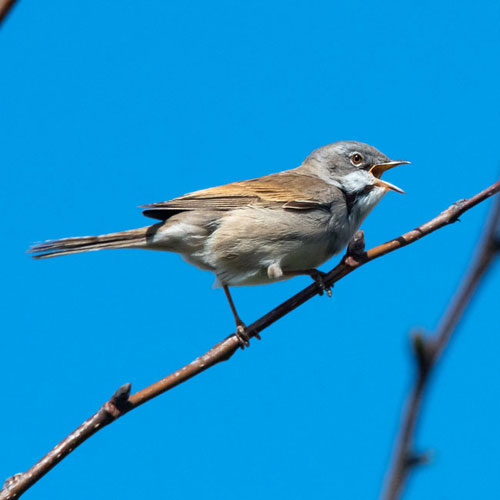 |
| Small Tortoiseshell Butterfly |
Red Admiral |
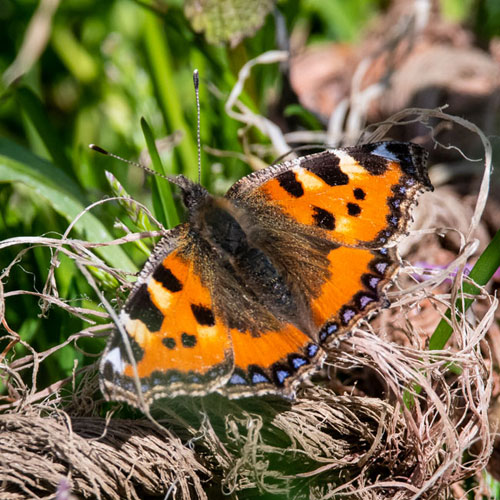 |
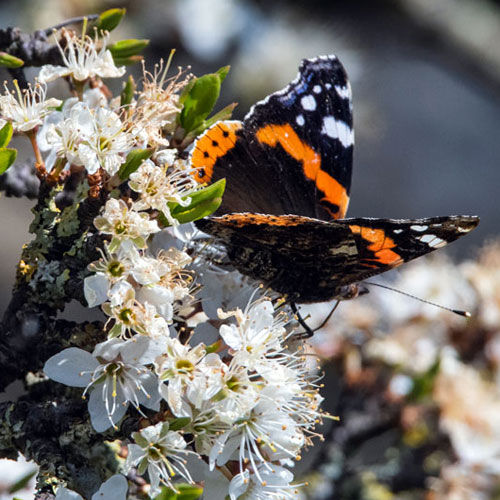 |
Wildflowers were blooming in the borders of the field. I snapped some pretty Red Campion and
some not so pretty Dog’s Mercury. At the Castle we watched a large queen Buff-tailed
Bumblebee buzzing around Hawthorn blooms. In the same shot there is a 7-spot Ladybird
(bottom right). We clambered up the steep slope to the Castle ruin. I wondered what it might have
looked like in its heyday.
There was a fine view to the south-west of Greenan Castle. You can just make out Arran and the
Mull of Kintyre on the horizon.
We walked eastwards along a rough path along the edges of cornfields. We watched Starlings
searching out worms along the grassy paths and a watchful Blackbird perched above us on a
telephone cable.
| Starling |
Blackbird |
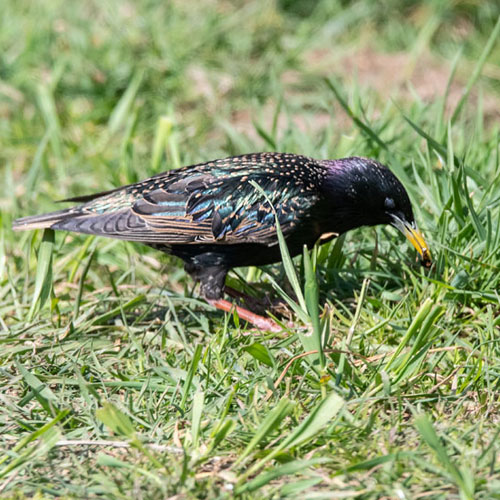 |
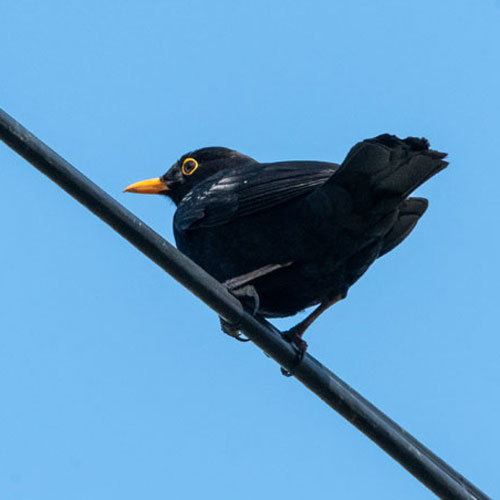 |
Below is the view to the North over Ayr. Note the very low tide. We were distracted by another
flock of twittering and flighty Goldfinches while taking this shot. Try as we might, we were unable
to find them in a photographable position.
We descended from the fields onto a well-surfaced path. We decided to search the hedgerows
lining the path and were rewarded with shots of some common garden birds: a Chaffinch,
Dunnock and, at long last, a Goldfinch posing wonderfully on a tree branch. A warbling Robin
added to our joy as it too sat briefly overhead as we rested briefly for drink.
| Chaffinch |
Dunnock |
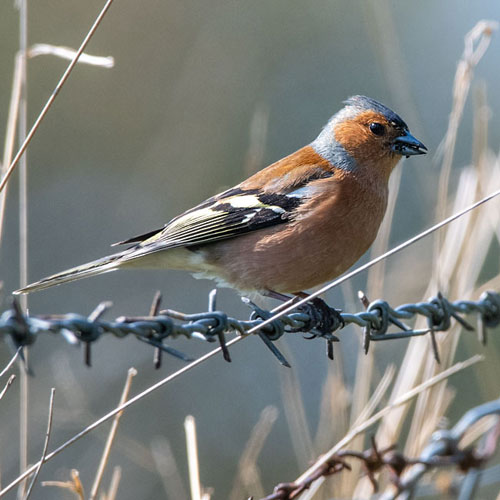 |
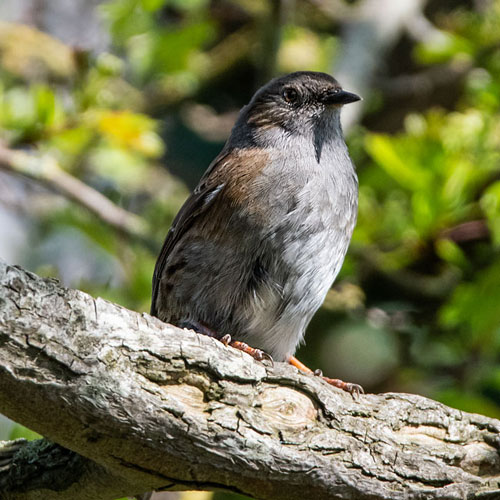 |
| Goldfinch |
Robin |
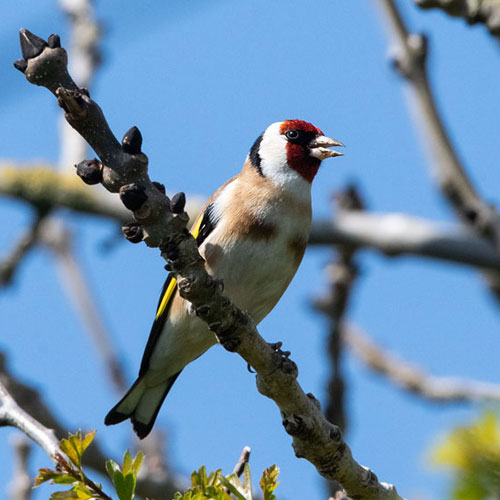 |
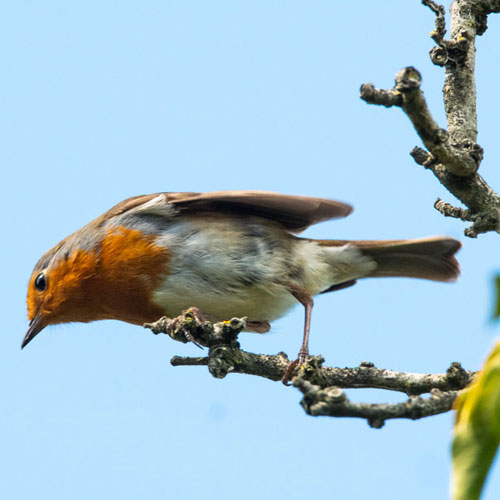 |
I noticed a large black fly, probably the Bluebottle Fly, Calliphora vomitoria landing on a
strand of long grass. And then an energetic Green-veined White butterfly appeared on the scene.
After a brief chase I managed a couple of quick shots, the one below showing nicely its veins of
green on the underwing. As we wandered away from the hedges John spotted a growth on the
branches of a tall Dog Rose tree. We reckon it is a spent Rose Gall called Robin’s
Pincushion. It is caused by the Gall Wasp which lays eggs on the leaf or stem. Just before we
returned to the car park I got a nice capture of a female House Sparrow perching on a rose bush
at the back of a garden.
| Fly-Calliphora Vomitoria |
Green-veined White Butterfly |
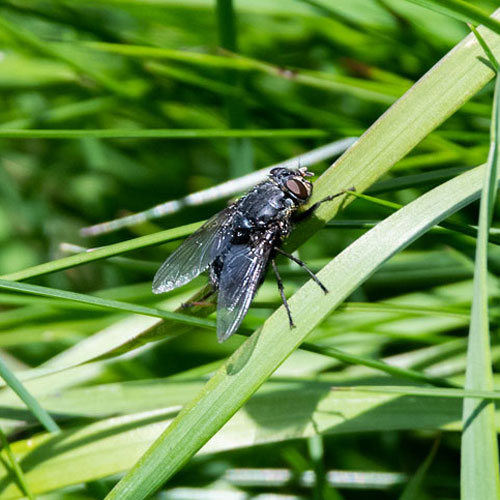 |
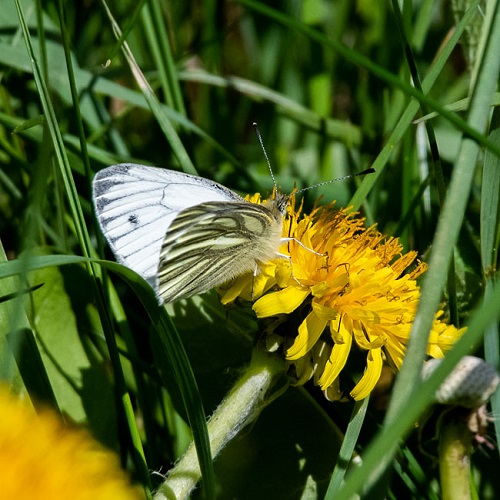 |
| Rose Gall |
Female House Sparrow |
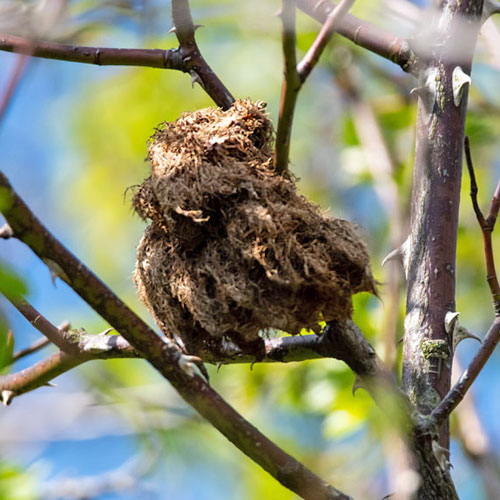 |
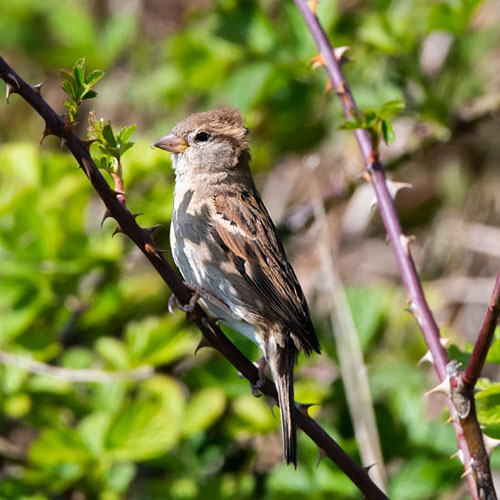 |
We relocated to the Castle Walk car park for a brief investigation around the adjacent pond and
the area along the outflow of the Riven Doon. We saw a drake Mallard and watched a very
accommodating male Pied Wagtail as it picked its way along the stream adjoining the pond and
the River Doon.
The river estuary was hosting what looked like a paddleboard class with around ten novice
paddleboaders. That ensured that there were no birds there. We could see only the usual
assembly of Gulls further downstream, but, satisfied with our haul of pictures thus far, we decided
not to venture beyond the aforementioned stream. Instead, we finished the trip with a few shots of
flowers we saw around the pond. I discovered a bonny bush of Common Scurvygrass , an
awful name for a pretty flower. Apparently its association with scurvy arose from the navy’s use of
the plant as a dietary supplement to help prevent scurvy. John found a patch of long grass where
Daffodils and Common Bluebells were blooming. On the way back to the car I noticed some Field
Speedwell on growing on the short grass.
| Common Scurvygrass |
Daffodil |
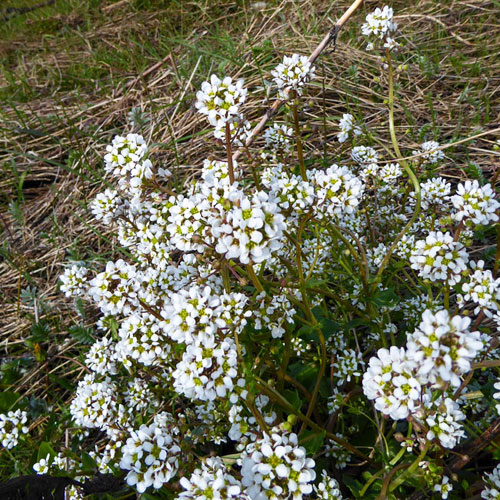 |
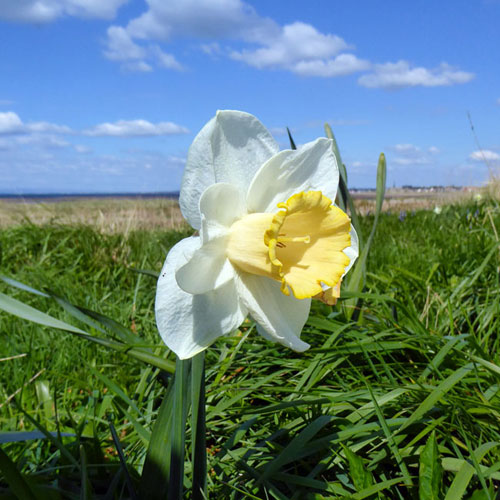 |
| Common Bluebell |
Common Field Speedwell |
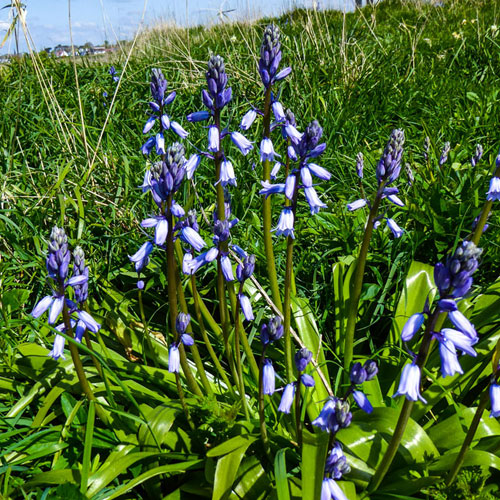 |
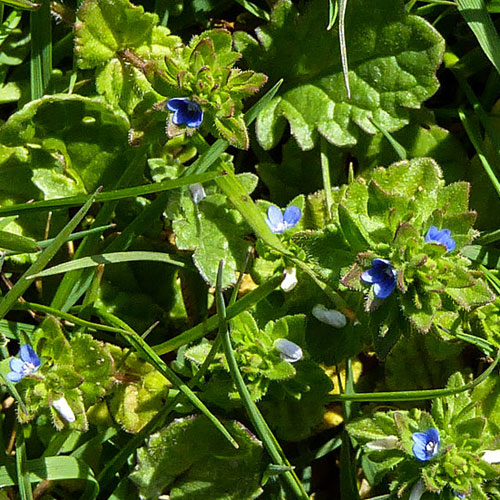 |
Surprisingly, we saw no coastal sea birds apart from Gulls on our long-awaited outing to the
coast. However, we were very pleased with what we saw, particularly the Willow Warbler and
Whitethroat and, of course the butterflies. We had our first tea and strawberry tarts for over a
month to end the visit (only to discover the pastry was a bit soggy). Let’s hope the weather keeps
up for next week, and the tide is more favourable
Week ending: 17th April 2022 : RSPB Baron’s Haugh and Dalzell Estate
There was no Sunday visit this week as both John and I had Easter Bunny commitments.
However, on Saturday afternoon, I managed a couple of hours at RSPB Baron’s Haugh
where I had a fairly productive time. The weather was dry but dull with only very brief spells of
sunshine.
I usually approach the RSPB reserve from the adjoining Dalzell Estate, as it offers the possibility of
more sightings. My first picture was of multiple Birch Polypore fungi attached to a Silver
Birch tree. My first bird sighting was of a Magpie on a tree in the Japanese Garden . In the
woods adjacent to the Garden I snapped some nice shots of a Blue Tit and a Great Tit as they fed
on Alder flowers.
| Birch Polypore |
Magpie |
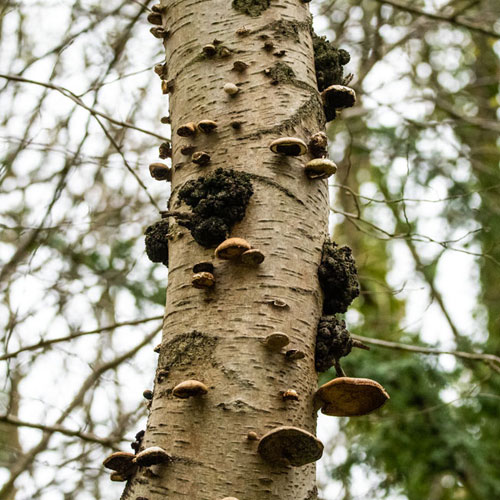 |
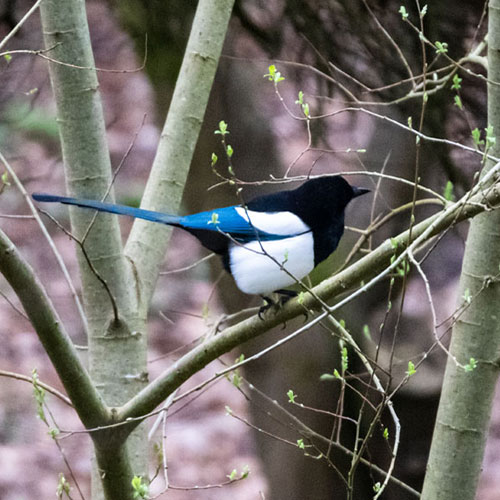 |
| Blue Tit |
Great Tit |
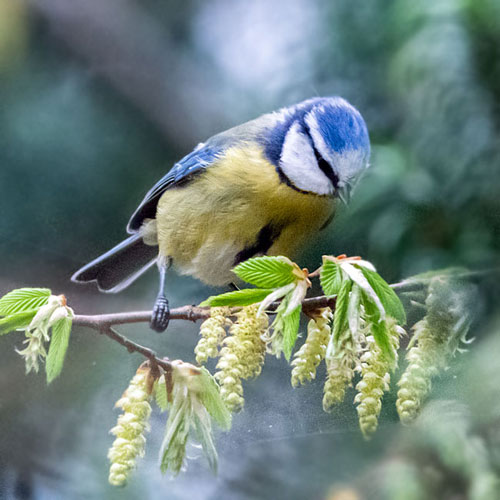 |
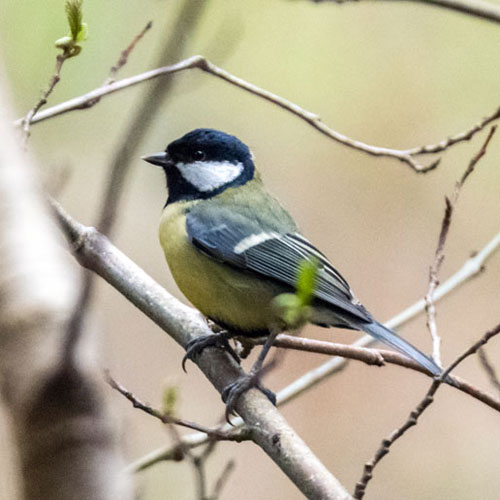 |
Spring wildflowers were blooming and I photographed quite a few on my passage through the
Estate. Primroses were dotted throughout clearings in the woods while Wood Anemones and
Opposite-leaved Golden Saxifrage were growing at the pathside. As I “wandered lonely as a
cloud” I also encounter crowds of golden Daffodils. I noticed that the Lesser Celandine flowers
were charmingly half shut due to the dim light. As I descended the stairs to the Chestnut Walk
there were Bluebells coming into bloom - the first of very many.
| Primrose |
Wood Anemone |
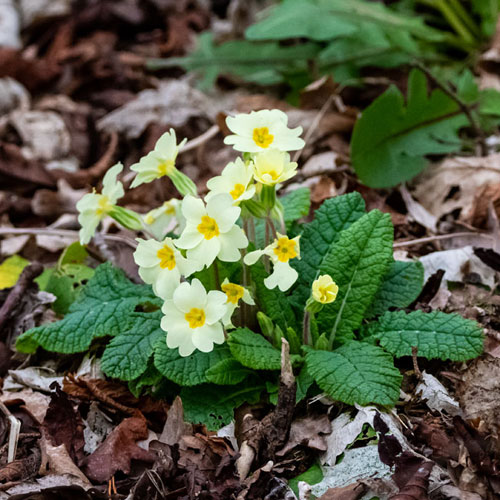 |
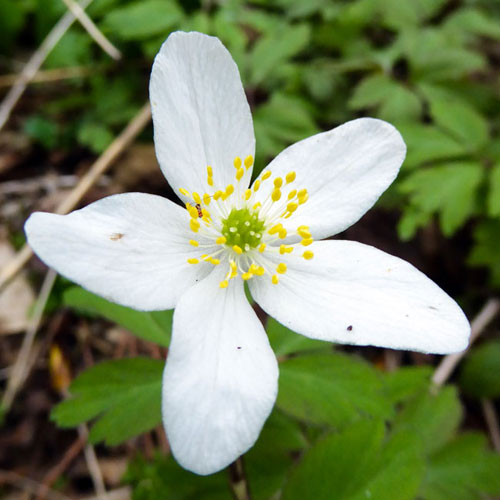 |
| Opposite-leaved Golden Saxifrage |
Daffodil |
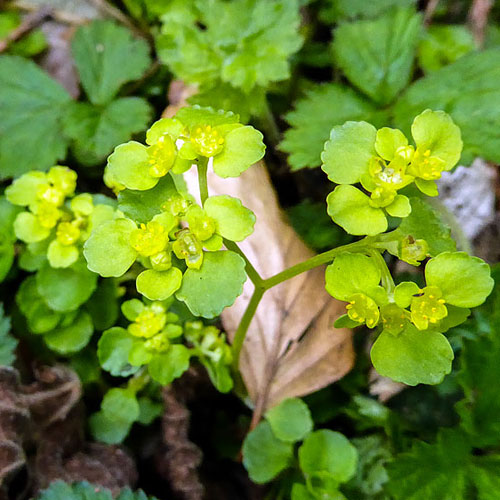 |
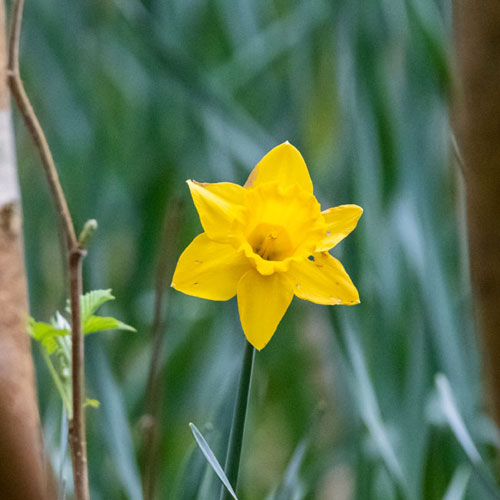 |
| Lesser Celandine |
Bluebell |
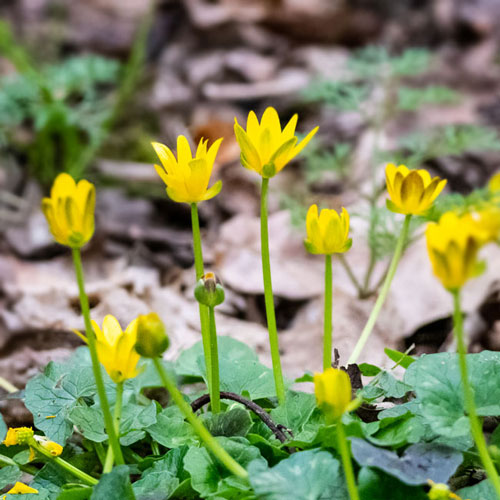 |
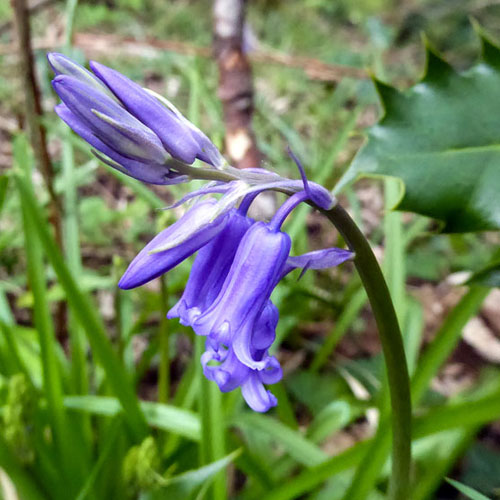 |
Left and right of the Chestnut Way was packed with Few-flowered Leeks whose “oniony” smell
filled the air. I also noticed charming pink Cuckoo Flowers. I thought I heard a Woodpecker
tapping on the bark of a tall Horse Chestnut tree. In fact it was a Nuthatch , probably
preparing a nesting site.
Eventually I reached the much eroded banks of the River Clyde. (Great care was required at
several parts of the route due to the damage caused to the paths by the river floods. They were
impassable, particularly around the Phoenix Hide.) I was delighted to hear and then see a
Chiffchaff, my first of the year. Near it, a Blue Tit was performing acrobatics as it fed on
Hawthorn leaf shoots. On other Hawthorn bushes further along the path I encountered another
first for the year, a very accommodating Willow Warbler that allowed me to capture some
very nice shots and even treated me to a wee song. Later, another Chiffchaff appeared further
along the path, close to the Centenary Hide.
Looking across the river I could see a few Goosanders sitting on the riverbank while a juvenile
Mute Swan swam in front of them. In the trees outside the Centenary Hide I managed a few shots
of some Chaffinches courting in the branches. Sadly, there was little to see from the hide.
| Male Goosander |
Juvenile Mute Swan |
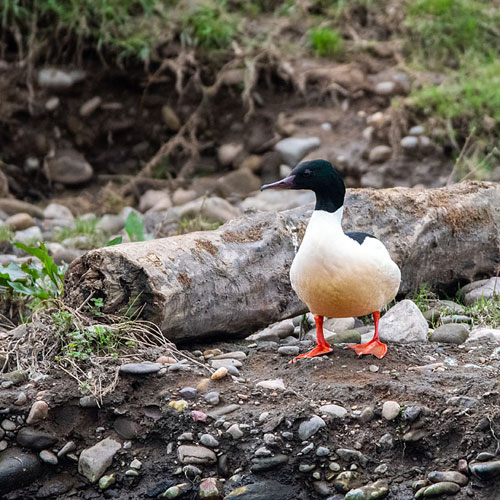 |
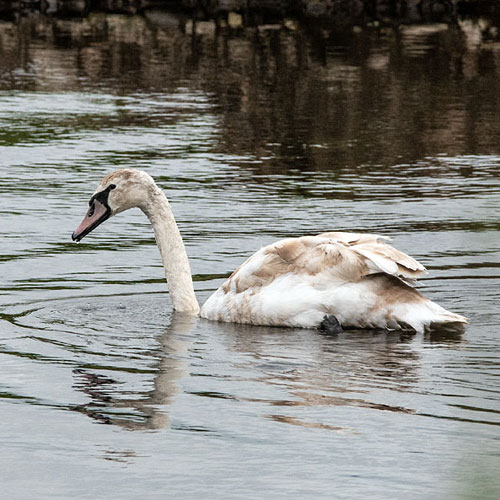 |
| Male Chaffinch |
Female Chaffinch |
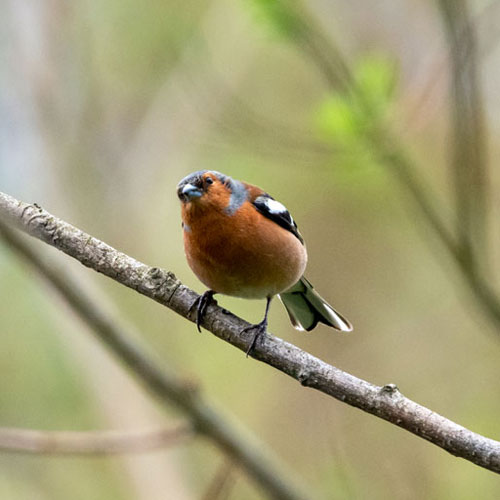 |
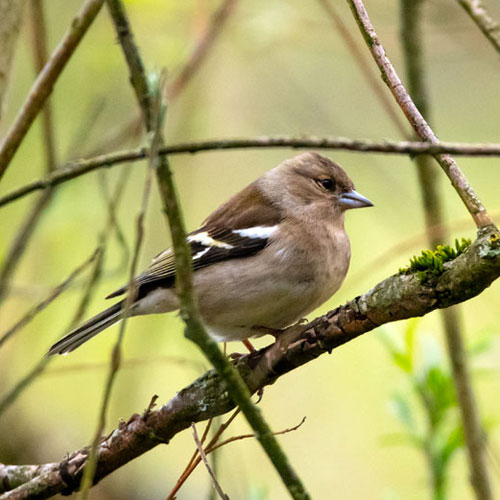 |
At the bend in the path near the Phoenix Hide I spotted a Blackcap, but it evaded the camera. But
as I tracked it I was fortunate enough to photograph a passing Long-tailed Tit. I also came across
some lovely Dog Violets and Barren Strawberry flowers.
The view from the Phoenix Hide was marginally better than that from the previous hide. I got
snaps of a Coot and a very distant Mute Swan’s nest - but little else. I continued my circuit along
the riverside with pictures of a Mute Swan and a Carrion Crow.
| Coot |
|
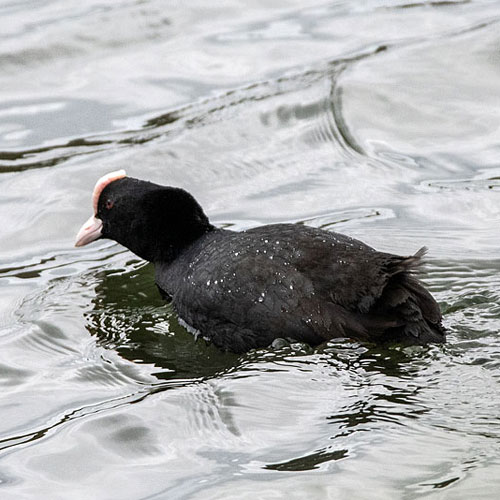 |
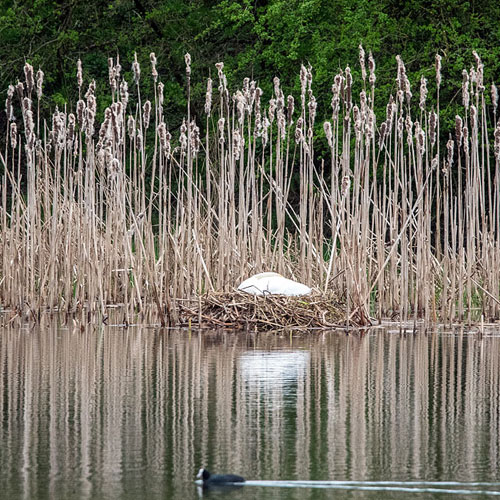 |
| Mute Swan |
Carrion Crow |
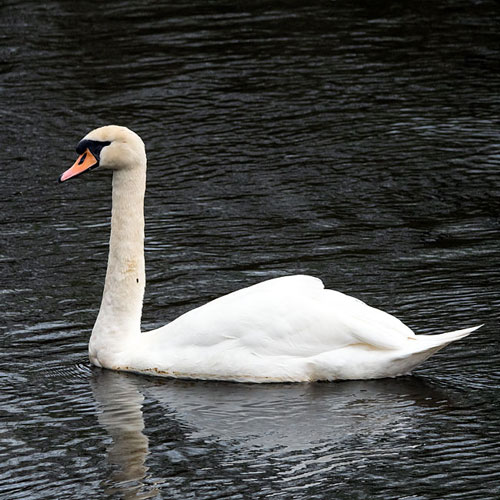 |
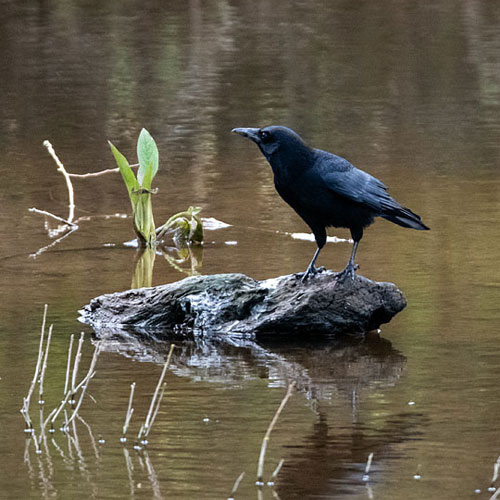 |
Just before the Causeway Hide I managed photos of a shy Robin and one of several Goldfinches
that were cavorting high in tree branches. One of the most interesting sights I saw, a first for me,
was a Raven mobbed by three Carrion Crows. Apparently such mobbings are common and
tend to happen when the Crows are nesting. My final shot was taken from the Marsh Hide where I
was lucky enough to see a Gadwall (as the light had become very poor).
It was a satisfying circuit. Baron’s Haugh is a fine nature reserve that nearly always rewards the
discerning observer. I was doubly rewarded with tea and biscuits back at the car. Next week, with
any luck, we should be back to normal
Week ending: 10th April 2022: Jim’s Garden and Strathclyde Country Park
Our usual Sunday visit was once again cancelled this week. I did though manage to get shots of
interest from Thursday to Sunday in and around my garden and also during a couple of short
visits to Strathclyde Country Park.
To supplement my reduced diet of birdwatching I have revived the use of the bird feeders in my
garden. We have plenty of feathered friends, mainly Starlings and House Sparrows. Other
common garden birds pop in and out such as a Blackbird pair hunting for worms.
| Starling |
House Sparrow |
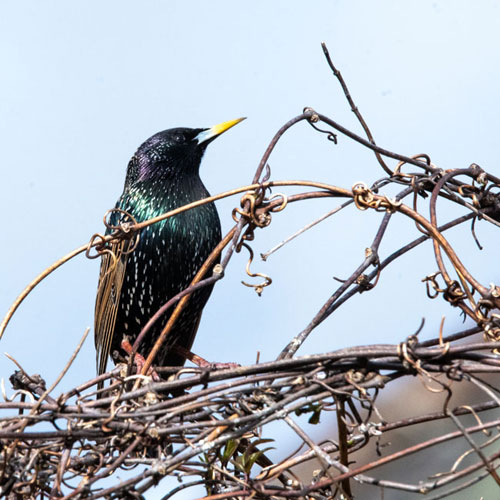 |
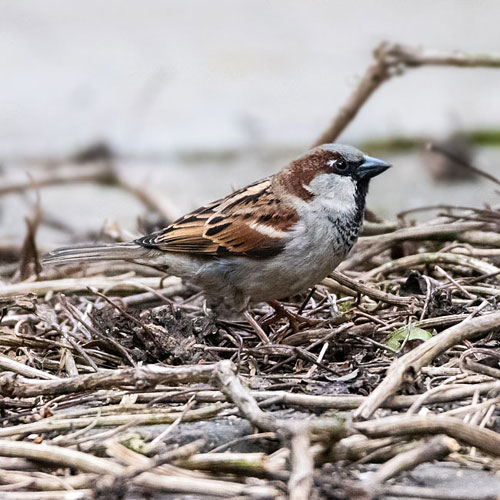 |
| Blackbird |
Female Blackbird |
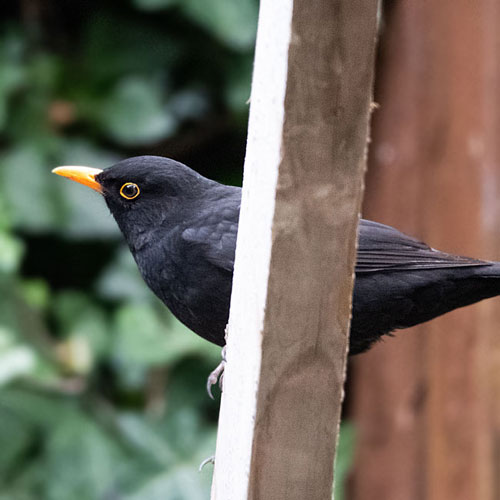 |
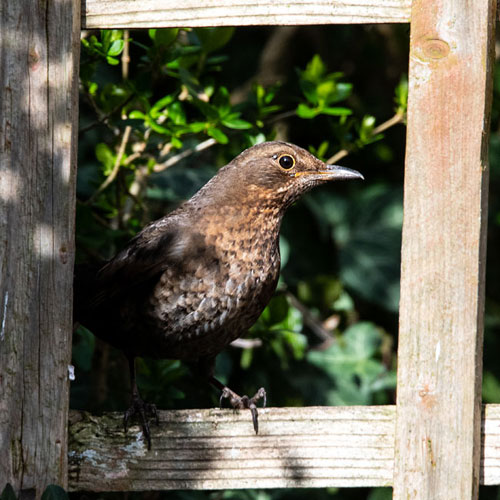 |
House Sparrows antics make them very photogenic, as I think the pictures below illustrate. They
can often be seen keeking out of the hedgerow before dashing for a sip of rainwater from the
flower ornament or a few seeds from one of my feeders. At this time of year the cock Sparrows
can be seen throwing shapes like nightclub posers to attract the females.
Flowers are beginning to grow and they, of course , attract insects. It was pleasing then to see
several species of Bumblebee visit my freshly bloomed Pieris Forest Flame shrub - Tree
Bumblebee, Buff-tailed Bumblebee and Early Bumblebee. And as a bonus I came across a
Clusterfly, probably the (Narrow-cheeked).
| Buff-tailed Bumblebee |
Early Bumblebee |
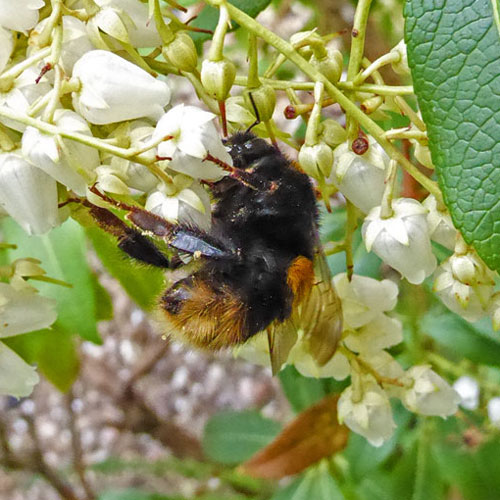 |
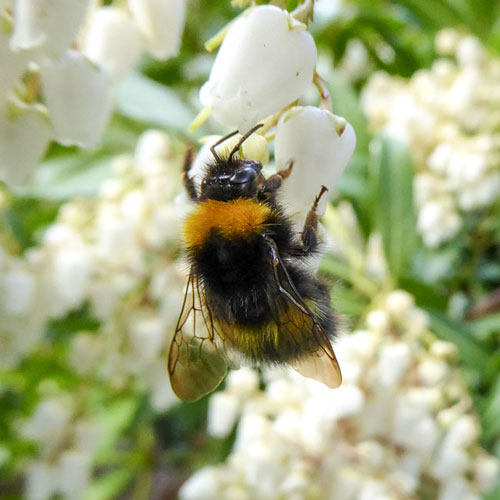 |
| Tree Bumblebee |
Narrow-cheeked Clusterfly |
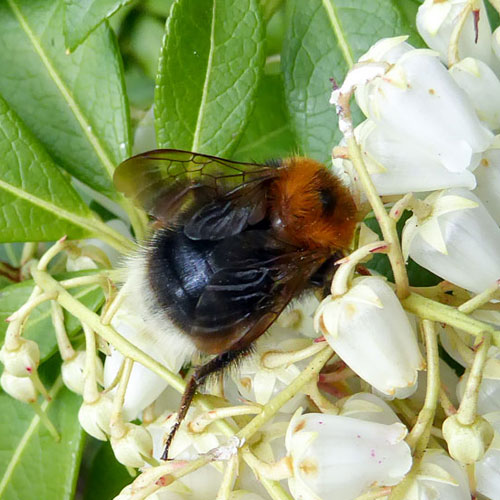 |
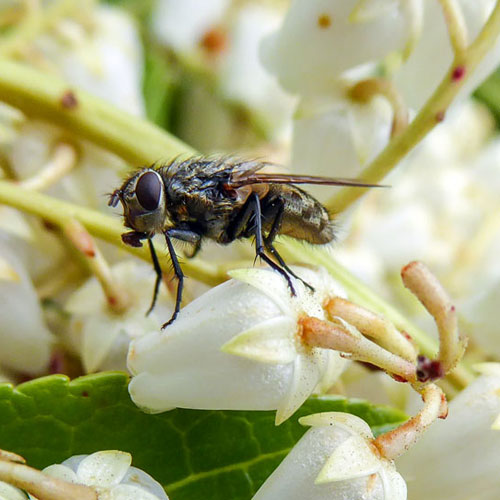 |
A couple of Blue Tits have discovered that my feeding station has reopened. They nip in and out
of the garden carefully avoiding the more dominant Sparrow flock. I also spotted a Great Tit on a
neighbours tree. Hopefully it too will visit my garden for a free feed and a beer photo. The Feral
Pigeon flock haven’t quite discovered the feeders - yet. A solitary Pigeon turned up on Sunday to
hoover up some of the spillages made by the messy Sparrows. A surprise visitor turned up as I
was reversing out of my driveway. A Greylag Goose waddled slowly across the road bringing the
heavy traffic to a standstill. Unfortunately I had an appointment so couldn’t hang about but
concerned pedestrians were trying to help it as I left.
| Blue Tit |
Great Tit |
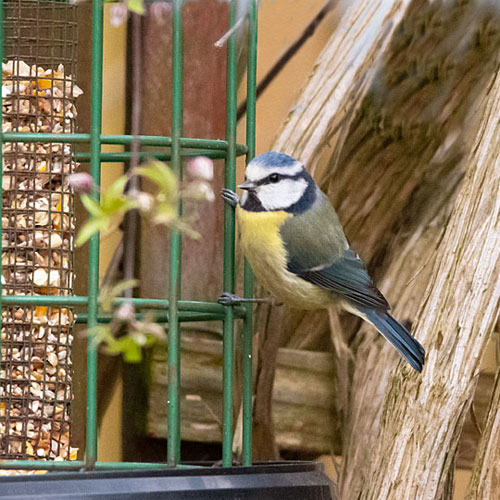 |
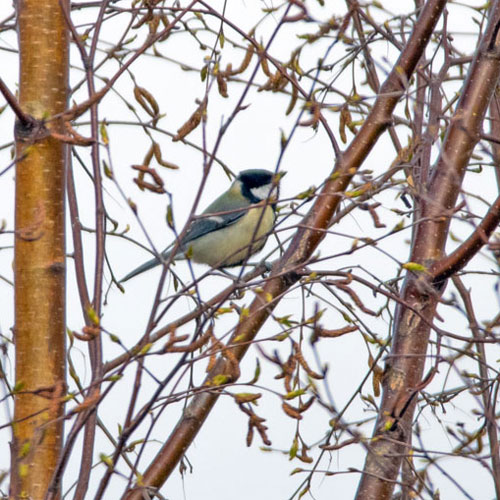 |
| Feral Pigeon |
Greylag Goose |
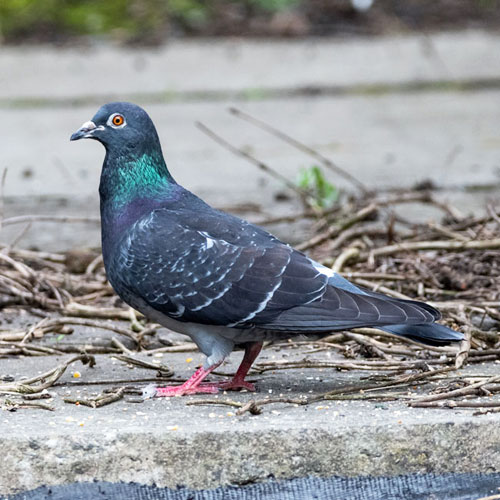 |
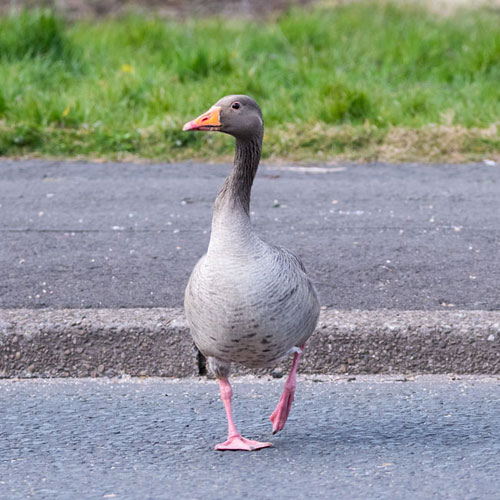 |
I also read of three interesting visitors to Strathclyde Country Park so I made several brief visits to
see if I could get pictures of them. The first of these was a juvenile Iceland Gull. It’s
plumage had no dark markings so it really stood out in a flock of similar-sized gulls. It wasn’t hard
to find as it “comes to bread” so I stood in Car Park 4 and waited for people with bread and
before too long I had some fairly decent photos. The second bird I was after was a female Scaup that had been seen with the Tufted Duck flock. I had to wait until my third visit to
Strathclyde Park to see it drift past Car Park 4. It is distinguished from the female Tufted Duck by
a broad white band above the beak and the absence of a tuft on its head.
The third bird I was seeking was a Little Gull, however it evaded me until I got a distant sighting
on my final visit to Strathclyde Park. Of course, I did see plenty of other birds. The
aforementioned Tufted Ducks were fairly mobile and could be seen almost anywhere on the Loch.
The Jackdaws are always a good watch, like the one shown below having a quick bath.
The Loch’s Cormorant flock gather near the Roman Bathhouse.
Around the same area a Carrion Crow looked down on me as I got some nice shots of a warbling
Robin. Soon after that I spotted a Sparrowhawk being harassed by an angry Crow. I also
got shots of a feeding Magpie and a well-illuminated Greylag taking the sun on the shore of the
loch. My final shot is of a cheeky Grey Squirrel that was beside my car as I returned from
observing the Little Gull. As I raised my camera it ran off but stopped some 10m away and held a
pose until I had my shot.
| Robin |
Carrion Crow |
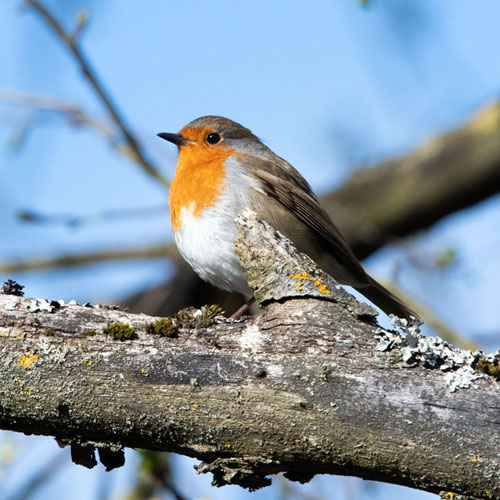 |
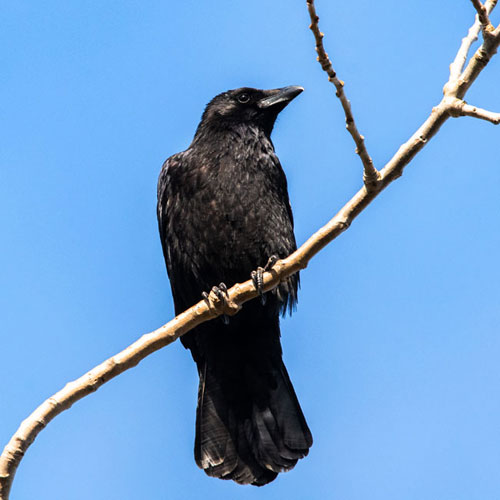 |
| Sparrowhawk / Carrion Crow |
Magpie |
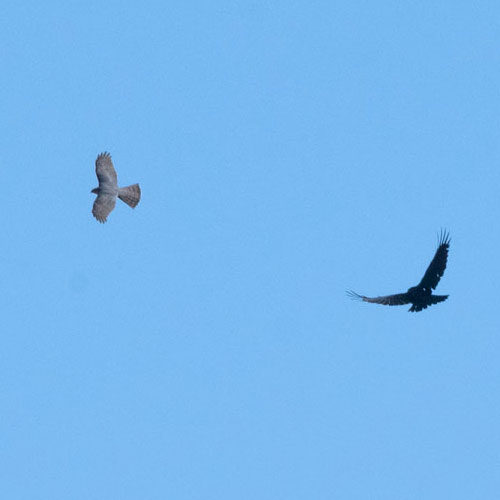 |
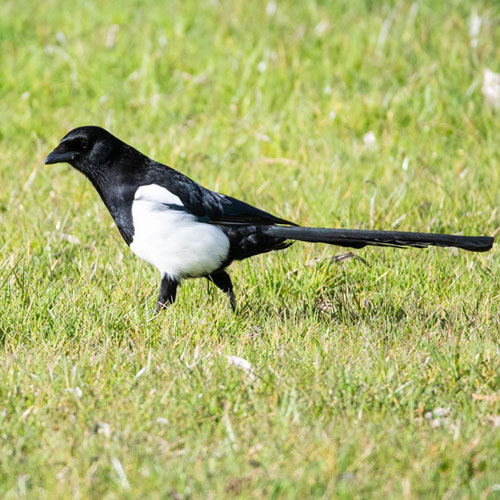 |
| Greylag Goose |
Grey Squirrel |
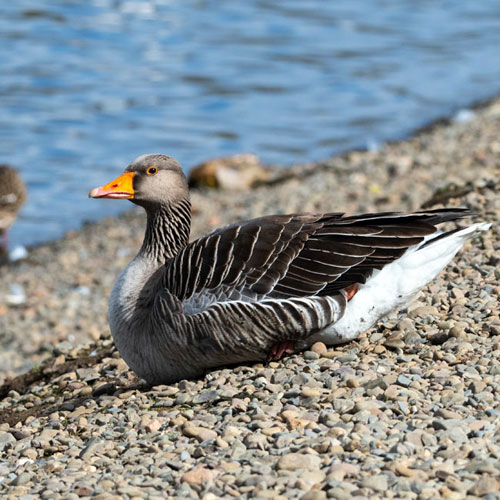 |
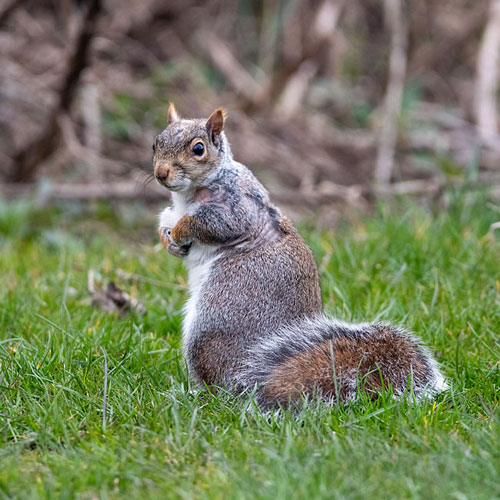 |
I am confident that John and I can travel a little further afield at the weekend. Let’s hope that we
get some nice weather
Week ending: 3rd April 2022: Strathclyde Park
This is a shorter Blog this week as I was restricted to one very short visit on Saturday to
Strathclyde Country Park. (We hope to get our regular Sunday visits back to normal before too
long).
It was a pleasant afternoon at Car Park 4 where I spent an unexpectedly active hour recording
some birdy events perhaps unnoticed by the majority of the very many walkers circulating the
Lochside pathways.
A good example of this could be the activities of the Mallards that were gathered at the side of the
Loch, ostensibly to receive bread from the kind humans. They were doing this, but between
feeding sessions they were still noticeably very active, in fact, exited, with much preening,
flapping and head-nodding.
… and some female Mallards were flying off. However other females were apparently swimming
up to, perhaps wooing the drakes (males). They would then suddenly dive below the water
followed just as suddenly by a drake.
The surprise to anyone watching is that the two ducks surfaced together - very together. I then
realised that the Mallard flock were engaged in courtship behaviour. The surfacing ducks
were copulating.
But unfortunately for them it was “coitus interruptus”: their romance was cut short by another
drake who fancied a bit of the action, or perhaps he was the wronged partner of the female. In
any case it all finished with a big splash and a chase.
The Mute Swans were also showing signs of courtship. There seemed to be a hierarchy at work
where the dominant cobs (males) are aggressive towards the younger cobs. The other sign of
courtship is where the cob and pen (female) come face-to-face and bow their heads. Dipping their
bills into the water. This is accompanied by brief entwining of their long necks. I did not see any of
the Swans pairs continuing to full copulation, but I suspect if I had watched for another
hour I might have.
By comparison with the Ducks and Swans, the Greylag Geese were much less animated.
Maybe they court later in the month.
There was no evidence I could see of courtship amongst the Gulls - Lesser Black-backs,
Common and Black-headed Gulls. They all seemed much too interested in mobbing people
throwing bread.
Jackdaws too were seeking bread, or more correctly, bread crumbs left by the bigger birds. I
noticed a large Cormorant flying southwards along the middle of the Loch. At the other end of the
size scale many walkers were complaining of the Midges, of which there were many. They needn’t
have worried as they were Chironomid Midges , non-biting midges.
| Jackdaw |
Cormorant |
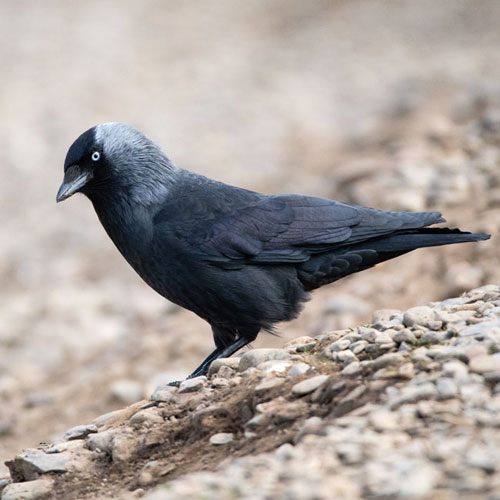 |
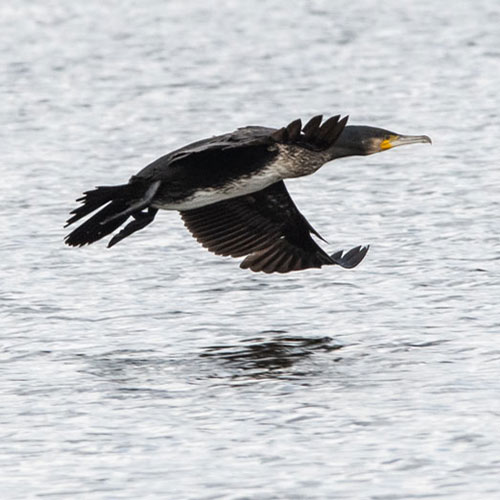 |
After snapping shots of the Midges I noticed that more Cormorants had grouped in the
middle of the Loch and were hunting fish as one large diving flock.
It was a very impressive site watching about twenty Cormorants continually diving and moving
down the Loch at about the speed of a fast walker. I have in the past seen them bring fish to the
surface, but not so on this occasion.
I retired to the car for tea and biscuits before returning home. It had been brief but interesting hour
spent in Car Park 4. Hopefully John and I can soon get back to the coast.
Highlights
- April 2022
We present this month’s gallery of my
favourite pictures I’ve taken during April 2022. They are
not listed in the order they have been taken, but according to a series
of themes. I’ve kept
commentary to a minimum, preferring to let each picture talk for itself.
WEE BIRDS
FLOWERS 1
WINGS
INVERTEBRATE
SHORE BIRDS
FLOWERS 2
MAMMALS
Back To Top
|

